We’ve all dreamed of having a beautiful garden that doesn’t demand hours of our precious weekends. The good news? Creating a stunning low-maintenance garden that thrives with minimal effort isn’t just possible – it’s easier than you think.
Gone are the days when gorgeous landscaping meant constant weeding, daily watering, and endless pruning. Today’s smart gardening approaches focus on working with nature rather than against it. By choosing the right plants, implementing clever design strategies, and using time-saving techniques, we can create outdoor spaces that practically care for themselves.
Whether you’re a busy professional, new homeowner, or simply want to spend more time enjoying your garden instead of laboring in it, we’re about to share game-changing ideas that’ll transform your outdoor space. These proven strategies will help you cultivate a thriving garden that looks professionally maintained while requiring just minutes of your time each week.
Choose Drought-Tolerant Plants for Year-Round Beauty
Drought-tolerant plants form the backbone of any successful low maintenance garden design. These resilient species thrive with minimal water while delivering stunning visual appeal throughout every season.
Native Wildflowers and Grasses
Native wildflowers establish deep root systems that naturally access groundwater without frequent irrigation. Purple coneflowers, black-eyed Susans, and blanket flowers bloom continuously from spring through fall with virtually no care beyond occasional deadheading.
Ornamental grasses like buffalo grass, blue grama, and little bluestem create movement and texture while requiring water only during extreme drought conditions. Prairie dropseed and fountain grass add vertical interest to garden beds while self-seeding for natural expansion year after year.
We recommend planting native species in clusters rather than single specimens to create dramatic impact with less effort. Most wildflowers and grasses actually perform better in poor soil conditions, eliminating the need for fertilizers or soil amendments.
Succulents and Cacti Varieties
Succulents store water in their thick leaves and stems, making them perfect for gardeners who travel frequently or forget to water. Sedums, hens and chicks, and ice plants spread naturally to form colorful ground cover that suppresses weeds effectively.
Barrel cacti, prickly pear, and cholla varieties provide architectural structure while blooming with vibrant flowers in spring and summer. Agaves and yuccas serve as stunning focal points that can survive years without supplemental watering once established.
Container gardens featuring jade plants, echeveria, and string of pearls bring low maintenance beauty to patios and decks. These plants typically need water only when soil feels completely dry, often just once or twice monthly during growing season.
Mediterranean Herbs and Shrubs
Mediterranean plants evolved in dry climates and actually prefer less water than traditional garden favorites. Lavender, rosemary, and thyme provide fragrant foliage while attracting beneficial pollinators throughout the growing season.
Sage varieties offer silvery leaves and colorful flower spikes that deer and rabbits typically avoid. Oregano and marjoram spread to form aromatic ground cover while providing fresh herbs for cooking year round.
Shrubs like oleander, bottlebrush, and rockrose create privacy screens and windbreaks without regular pruning or fertilizing. These plants bloom repeatedly with minimal care while tolerating both drought and occasional flooding conditions.
We find that grouping Mediterranean plants together creates microclimates that further reduce their water needs while maximizing their ornamental impact in the industry.
Design Your Garden Layout for Minimal Upkeep

Strategic garden design transforms maintenance demands while creating beautiful outdoor spaces. We’ll explore layout techniques that significantly reduce your gardening workload.
Create Defined Pathways and Borders
Hardscaping materials replace high maintenance lawn areas with functional alternatives like pavers or gravel. These surfaces eliminate mowing requirements while creating clean, accessible routes throughout your garden space.
Monkey grass borders provide low maintenance definition between garden beds and pathways. This clumping ornamental grass adds visual interest without requiring frequent trimming or replacement like traditional border plants.
Gravel pathways offer durability and drainage while suppressing weed growth naturally. We recommend installing industry fabric beneath gravel to maximize weed prevention and reduce long term maintenance needs.
Group Plants by Water and Care Requirements
Plant placement according to water needs creates efficient irrigation zones throughout your garden. Grouping drought tolerant species together reduces watering frequency while clustering moisture loving plants in separate areas.
Native plants thrive in existing soil conditions without requiring additional fertilizers, pesticides, or frequent watering. These species naturally adapt to local climate patterns and support regional wildlife populations.
Lavender thrives in well draining soil but struggles in waterlogged conditions, demonstrating why proper plant placement matters. We suggest placing Mediterranean herbs together in raised areas while positioning moisture loving plants in naturally damp spots.
Incorporate Hardscape Elements
Large pots and raised planters reduce watering frequency compared to smaller containers that dry out quickly. These elevated growing spaces also improve drainage and make maintenance tasks more accessible.
Artificial turf eliminates lawn care completely while providing green coverage year round. This option works particularly well in urban gardens where natural grass struggles to establish properly.
Decking and paving replace lawn areas that require regular mowing and fertilizing. These permanent surfaces create entertaining spaces while dramatically reducing weekly garden maintenance tasks.
Install Efficient Watering Systems
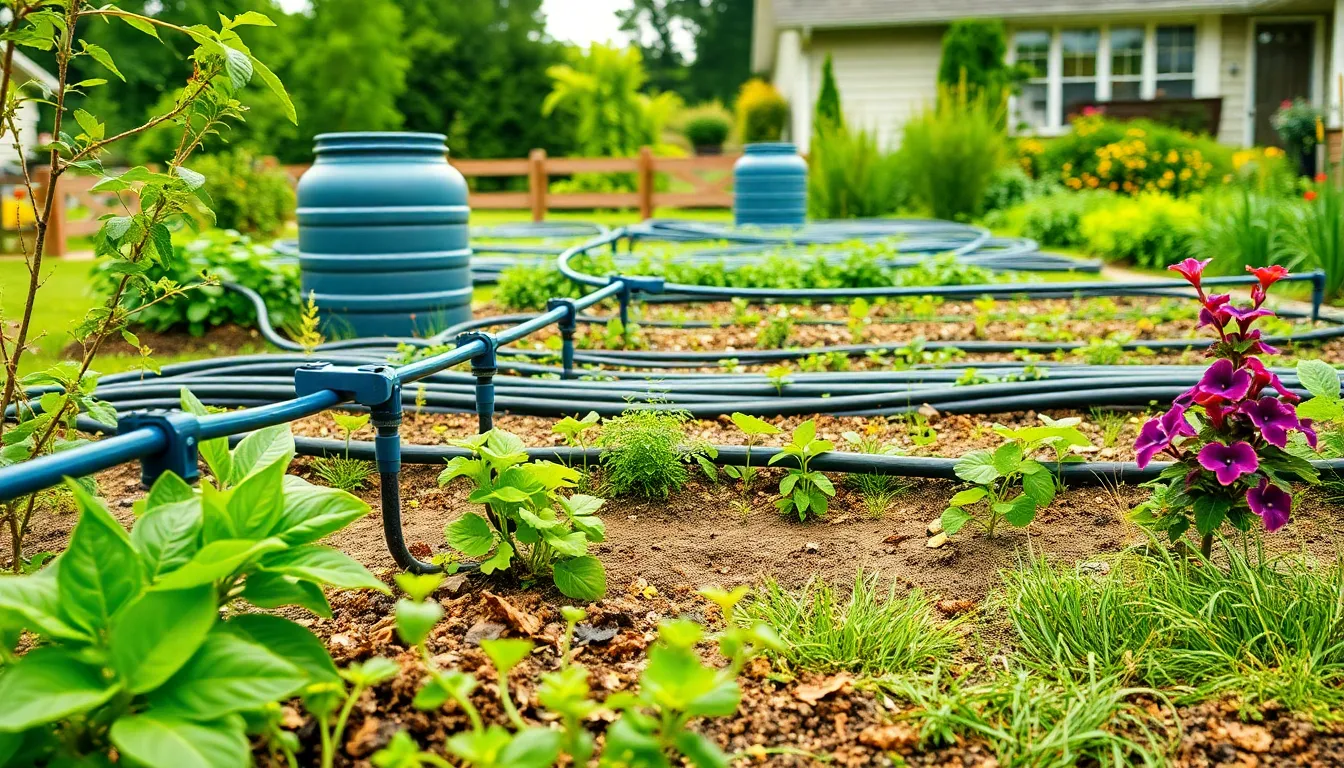
Smart irrigation answers transform your garden into a self-sustaining oasis. These systems deliver water precisely where plants need it while reducing our maintenance workload significantly.
Drip Irrigation for Targeted Moisture
Drip irrigation delivers water directly to plant roots through a network of tubes and emitters. This precise method reduces water waste by up to 50% compared to traditional sprinklers while ensuring consistent moisture levels. Plants receive exactly the hydration they need without excess water evaporating or running off.
We can install drip systems in vegetable gardens, flower beds, and container plantings with minimal technical expertise. The system operates at low pressure, making it gentle on delicate plants while penetrating deeply into soil. Most setups connect to standard garden hoses and include adjustable emitters that accommodate different plant water requirements.
Soaker Hoses for Garden Beds
Soaker hoses provide deep, slow watering that encourages strong root development throughout garden beds. Water seeps gradually through the porous hose material, saturating soil without creating surface runoff. This method proves especially effective for rows of vegetables, perennial borders, and shrub plantings.
Installation requires simply laying hoses along plant rows and connecting them to water sources. We can hide soaker hoses under mulch for aesthetic appeal while maintaining their effectiveness. The system works best when positioned 12 to 18 inches from plant stems, allowing water to spread naturally through soil.
Rain Barrels for Water Collection
Rain barrels capture and store free water from roof runoff for later garden use. A typical 55-gallon barrel collects approximately 600 gallons of water from a 1,000-square-foot roof during a one-inch rainfall. This harvested water reduces utility costs while providing plants with naturally soft, chemical-free irrigation.
Modern rain barrel systems include screens to filter debris, spigots for easy water access, and overflow valves for heavy rainfall events. We can connect multiple barrels together to increase storage capacity or attach them directly to soaker hoses for automated distribution. These systems require minimal maintenance beyond occasional cleaning and winter preparation in freezing climates.
Mulch Strategically to Reduce Maintenance
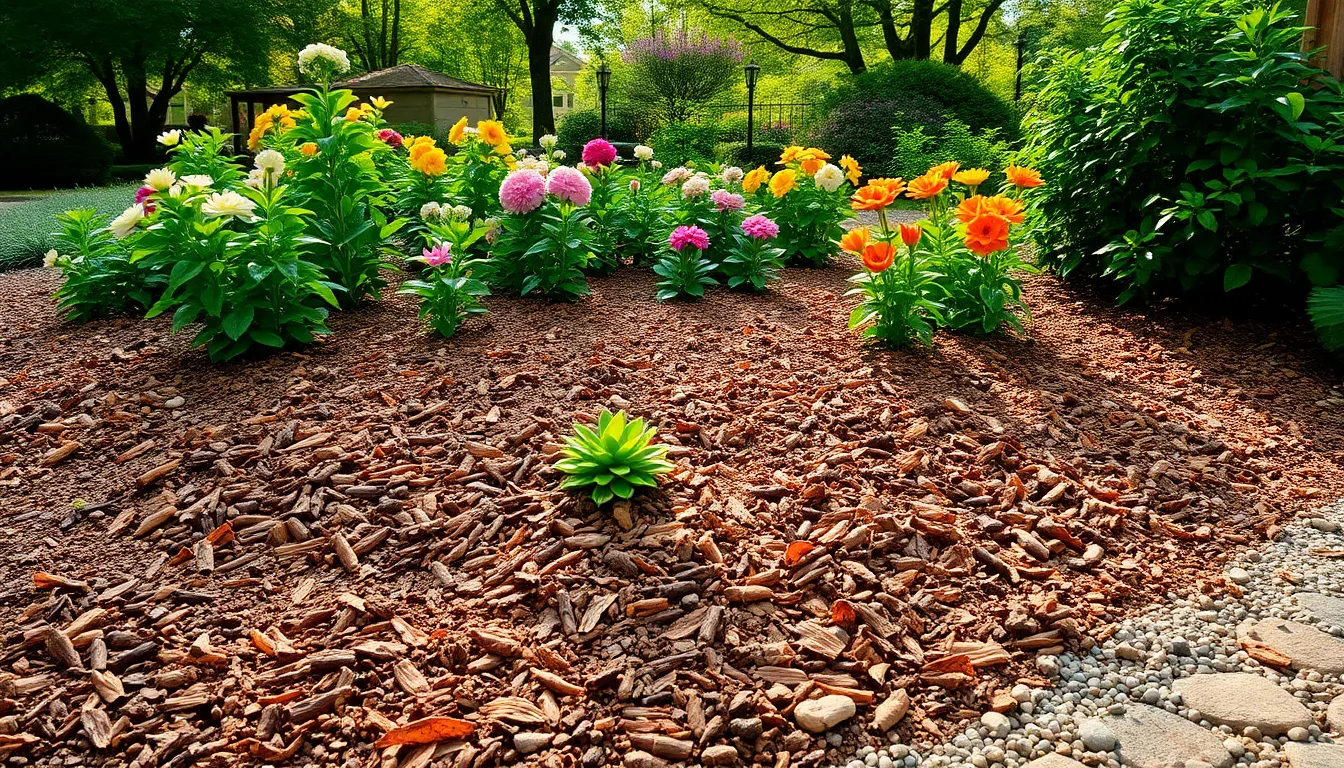
Mulching serves as one of the most effective strategies for creating a truly low maintenance garden. Smart mulch placement suppresses weeds while retaining crucial soil moisture throughout the growing season.
Organic Mulch Options for Soil Health
Organic mulches provide dual benefits by breaking down over time to enrich soil quality. Wood chips offer excellent weed suppression and gradually decompose to improve soil structure over several years. Leaf mold creates nutrient-rich organic matter that feeds beneficial soil microorganisms while maintaining consistent moisture levels.
Compost works exceptionally well as a mulching material, delivering nutrients directly to plant roots as it slowly decomposes. Bark mulch provides attractive visual appeal while lasting longer than finer organic materials. Grass clippings decompose quickly and return nitrogen to the soil, making them ideal for vegetable gardens and annual flower beds.
Inorganic Mulch for Long-Term Coverage
Inorganic mulching materials deliver long-lasting weed control without the need for annual replacement. Industry fabric blocks weeds effectively while allowing water and air to penetrate to plant roots. Plastic sheeting provides the most aggressive weed suppression for areas where we want permanent ground coverage.
Gravel mulch offers excellent drainage properties and works particularly well around drought-resistant plants and Mediterranean species. Stone mulch maintains its appearance for decades while reflecting heat that benefits warm-climate plants. Rubber mulch made from recycled tires provides cushioning for play areas while requiring virtually no maintenance.
Proper Mulching Techniques
Applying mulch correctly ensures maximum effectiveness while preventing plant damage. Spread organic mulch 2-3 inches thick around plants, maintaining this depth consistently across garden beds. Keep mulch several inches away from plant stems and tree trunks to prevent moisture buildup that can cause rot or pest problems.
Edge garden beds cleanly before applying mulch to create defined boundaries and prevent material from spreading into unwanted areas. Water the area thoroughly before mulching to ensure moisture reaches plant roots effectively. Replace organic mulches annually or when the layer thins to less than 2 inches to maintain optimal weed suppression and soil benefits.
Select Low-Care Ground Cover Options
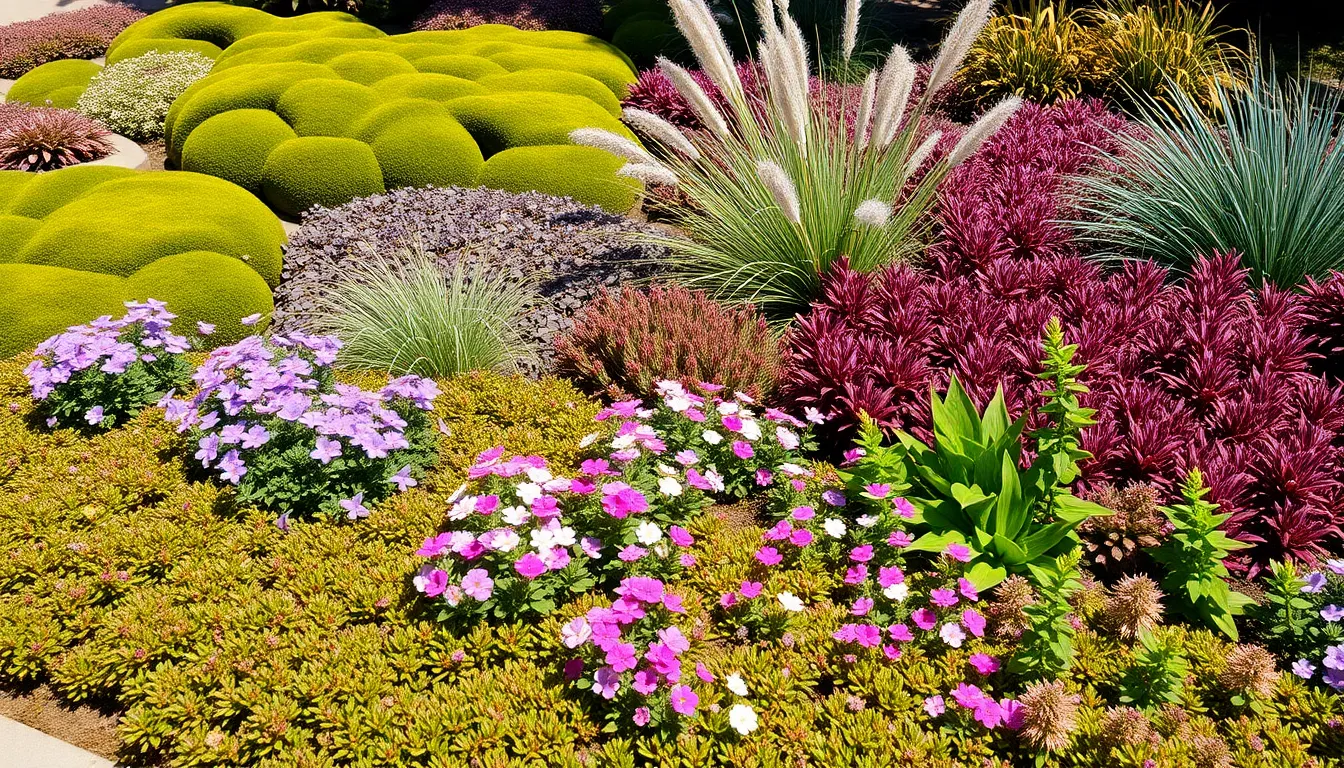
Ground cover plants create the foundation of our low maintenance garden strategy. These resilient options eliminate the need for traditional lawn care while providing year-round beauty.
Creeping Perennials for Living Carpets
Creeping thyme forms dense, fragrant mats that naturally suppress weeds and require minimal watering once established. This hardy perennial spreads across walkways and garden paths, releasing aromatic oils when stepped on. Purple or white flowers bloom throughout summer, attracting beneficial pollinators to our garden spaces.
Vinca minor thrives in shaded areas where grass struggles to grow, producing blue-purple flowers against evergreen foliage. Also known as periwinkle, this ground cover tolerates various soil conditions and requires virtually no maintenance after the first growing season. Dense growth patterns prevent weed emergence while creating uniform coverage across difficult terrain.
Creeping phlox cascades over slopes and rocky areas, producing vibrant spring blooms in pink, purple, or white. This drought-tolerant perennial forms thick carpets that eliminate erosion concerns while reducing our watering requirements. Established plants spread naturally through underground runners, filling gaps without additional planting efforts.
Ornamental Grasses for Texture
Pampas grass creates dramatic focal points with tall, feathery plumes that sway gracefully in garden breezes. These impressive grasses reach heights of 6-10 feet, providing natural privacy screens while requiring minimal care beyond annual trimming. Drought tolerance makes pampas grass ideal for water-conscious landscapes.
Blue oat grass offers striking blue-gray foliage that contrasts beautifully with other garden plants throughout the growing season. This compact ornamental grass grows 18-24 inches tall, forming neat clumps that require no regular watering once established. Golden seed heads emerge in late summer, adding seasonal interest to our low maintenance design.
Monkey grass serves dual purposes as both ground cover and attractive border definition between garden beds and pathways. Clumping varieties stay contained within designated areas, eliminating concerns about aggressive spreading. These versatile plants tolerate various light conditions while maintaining consistent appearance year-round.
Moss and Sedums for Shaded Areas
Moss thrives in moist, shaded conditions where traditional grass fails to establish, creating lush green carpets without any mowing requirements. This non-vascular plant absorbs water directly through its surface, eliminating root system maintenance concerns. Natural moss growth indicates healthy soil conditions while providing habitat for beneficial garden insects.
Sedum varieties offer drought-tolerant answers for challenging shaded spots, producing succulent foliage in diverse shapes, sizes, and colors. These versatile plants store water in their leaves, reducing irrigation needs while providing year-round visual interest. Flowering sedums attract butterflies and bees, supporting our garden’s network balance.
Creeping sedums spread horizontally across rocky or sandy areas, forming colorful mats that require no supplemental watering after establishment. Popular varieties include ‘Dragon’s Blood’ with red-tinted foliage and ‘Angelina’ featuring bright yellow-green coloration. These hardy succulents multiply naturally, filling empty spaces without additional planting investments.
Plant Perennials Instead of Annuals
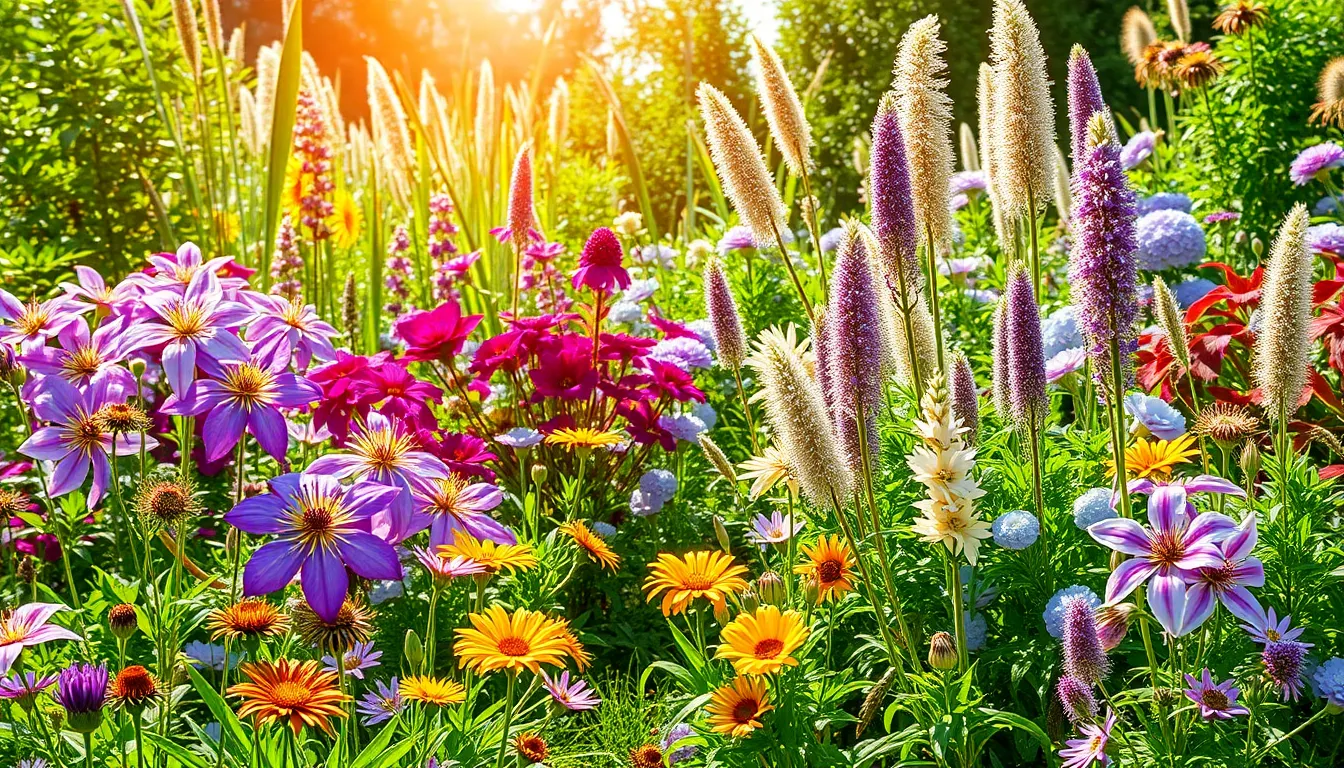
Perennials form the backbone of any low maintenance garden strategy. We’ll find these plants returning year after year without replanting, making them far more efficient than annuals that require seasonal replacement.
Long-Blooming Flower Varieties
Clematis varieties deliver months of continuous color from spring through fall, requiring minimal deadheading compared to shorter blooming alternatives. We can plant hydrangeas for extended flowering periods that often stretch from early summer into autumn. These long blooming perennials eliminate the need for frequent plant replacement while maintaining consistent garden appeal.
Japanese anemones provide late season blooms when most other flowers fade, extending our garden’s beauty well into fall. Daylilies offer successive waves of flowers throughout summer, with individual blooms lasting just one day but plants producing dozens of buds. Catmint creates purple blue spikes that bloom repeatedly when cut back, making it perfect for busy gardeners seeking continuous color.
Self-Seeding Plants for Natural Renewal
Cosmos naturally drop seeds that germinate the following spring, creating new plants without our intervention. We’ll discover that marigolds readily self seed in favorable conditions, producing volunteer plants that fill gaps in garden beds automatically. These self perpetuating flowers reduce our annual planting workload significantly.
Cleome develops distinctive seed pods that scatter freely, establishing new colonies of spider flowers each growing season. Four o’clocks reliably reseed themselves in warm climates, returning stronger and more abundant each year. Sweet alyssum carpets garden areas through natural reseeding, creating fragrant ground cover that requires zero replanting effort.
Nigella produces attractive seed heads that both provide visual interest and ensure next year’s blooms through natural dispersal. We can allow some flowers to go to seed rather than deadheading everything, encouraging this beneficial self renewal process.
Divide and Multiply Species
Hostas expand into larger clumps every few years, allowing us to divide them into multiple plants for free garden expansion. We can split these shade loving perennials in early spring or late fall, creating instant new plantings without purchasing additional specimens. This multiplication process actually improves plant health by preventing overcrowding.
Daylilies form dense clumps that benefit from division every three to four years, yielding many new plants from each original purchase. Astilbe responds well to division in early spring, with each separated section developing into a full sized flowering plant within one season. Iris rhizomes naturally multiply underground, providing abundant divisions that transplant easily to new garden locations.
Ornamental grasses like fountain grass create substantial clumps that divide into dozens of new plants, dramatically expanding our garden coverage at no additional cost. We’ll find that most perennials actually perform better after division, as it rejuvenates older plants while providing us with free propagation material.
Create Raised Beds for Better Control

Raised beds transform garden maintenance by elevating our growing areas above ground level. We gain complete control over soil conditions while reducing the physical demands of gardening.
Improved Drainage and Soil Quality
Better drainage becomes automatic when we build raised beds above ground level. Water naturally flows away from plant roots instead of pooling around them during heavy rains or overwatering. Excess moisture drains efficiently through the bottom of our raised structures.
Custom soil blends let us create perfect growing conditions for exact plants. We can mix compost, garden soil, and amendments to achieve ideal pH levels and nutrient content. Our vegetables and flowers thrive in this controlled environment without competing with existing clay or sandy ground conditions.
Root development improves dramatically in loose, well-structured raised bed soil. Plants establish stronger root systems that access nutrients more easily than in compacted ground. We see faster growth and healthier plants throughout the growing season.
Easier Weed Management
Fewer weeds germinate in raised beds because we start with fresh, weed-free soil mix. Existing grass and weeds remain below our elevated growing area and can’t easily spread upward. We eliminate most weed seeds that typically lurk in native soil.
Targeted weeding becomes simpler when weeds do appear in our raised beds. Small garden spaces make it easy to spot and remove unwanted plants before they establish deep roots. We spend minutes instead of hours dealing with weed control.
Mulching works more effectively in contained raised bed spaces. A 2-3 inch layer of organic mulch covers the soil surface completely and blocks light from reaching weed seeds. Our maintenance drops significantly when mulch suppresses new weed growth.
Reduced Bending and Maintenance
Higher growing surfaces eliminate constant bending and kneeling during garden tasks. We can build raised beds at comfortable heights that reduce strain on our backs and knees. Gardening becomes accessible for people with mobility limitations or joint problems.
Organized plant spacing in raised beds makes maintenance tasks more efficient. We can reach all areas of our garden beds without stepping on soil and compacting it. Harvesting, pruning, and watering become streamlined activities.
Defined borders keep our garden beds neat and contained without constant edge maintenance. Raised bed walls create clear boundaries that prevent grass from creeping into growing areas. We save time on trimming and reshaping garden edges throughout the season.
Incorporate Container Gardens Strategically
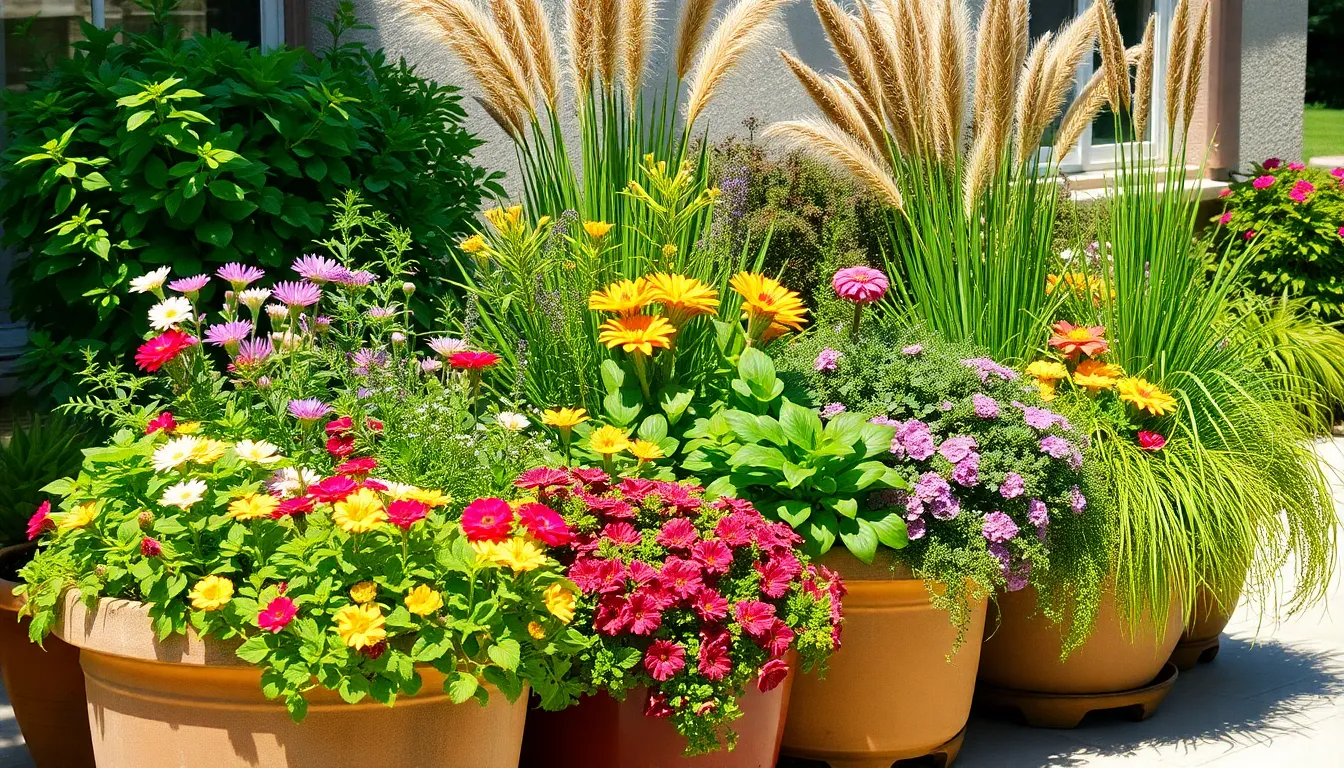
Container gardens offer unmatched flexibility for creating beautiful, low-maintenance outdoor spaces that adapt to our changing needs throughout the seasons.
Moveable Seasonal Displays
Container versatility transforms our garden design approach by allowing us to create seasonal displays that can be easily moved to different parts of the garden. We can position bright spring tulips near our front entrance, then relocate them to background areas once their blooms fade. Summer containers filled with heat-tolerant annuals, tropical foliage plants, herbs, and succulents thrive in full-sun locations while withstanding sweltering temperatures.
Seasonal blooms provide continuous visual interest as we rotate containers based on flowering periods and weather conditions. Moving containers to protected areas during harsh weather extends plant life and reduces replacement costs. Strategic placement near seating areas or focal points maximizes impact when plants are at their peak beauty.
Herb Gardens in Pots
Herb gardens represent the ultimate low-maintenance container solution since most herbs require minimal care and thrive in pots with good sunlight. We can position herb containers near our kitchen for convenient harvesting while ensuring they receive adequate light throughout the day. Popular choices like basil, cilantro, and parsley provide fresh ingredients with minimal watering requirements.
Year-round interest comes from perennial herbs like rosemary, thyme, and oregano that maintain their fragrance and utility through multiple seasons. These hardy herbs tolerate drought conditions and actually prefer slightly dry soil, making them perfect for busy gardeners. Container herb gardens also prevent aggressive spreaders like mint from taking over garden beds.
Statement Plants in Large Containers
Large containers create dramatic visual impact by featuring statement plants like dahlias or fuchsias that add bold color and architectural interest to our outdoor spaces. We can use oversized pots to anchor garden corners or frame entryways with plants that would otherwise require extensive ground preparation.
Mixing different plants such as perennials, bedding plants, and grasses in large containers creates visually appealing displays while reducing individual plant care requirements. Plants that thrive on neglect, including cacti, succulents, and aloes, work exceptionally well in large containers where their drought tolerance shines. These combinations provide varied textures and heights that create professional-looking arrangements with minimal ongoing maintenance.
Use Natural Pest Control Methods

Natural pest control transforms your low-maintenance garden into a self-regulating network that protects itself without chemical interventions. We’ll explore three proven strategies that reduce pest problems while maintaining the effortless beauty of your outdoor space.
Companion Planting for Pest Deterrence
Basil planted alongside tomatoes creates nature’s most effective aphid barrier. This classic pairing demonstrates how strategic plant placement eliminates pest problems without spraying or constant monitoring. Marigolds scattered throughout vegetable beds repel nematodes and whiteflies while adding vibrant color to your garden design.
Lavender borders naturally deter moths, fleas, and mosquitoes from entering garden spaces. We recommend planting this hardy perennial around seating areas and pathways where its fragrance provides dual benefits of pest control and aromatherapy. Chives growing near roses prevent aphid infestations while their purple blooms complement rose colors beautifully.
Nasturtiums serve as trap crops that attract cucumber beetles away from valuable vegetables. These fast-growing annuals require minimal care while protecting your main crops through strategic sacrifice. Garlic interplanted with lettuce and spinach creates an invisible shield against slugs and snails that would otherwise damage tender greens.
Beneficial Insect Attraction
Flowers specifically chosen for beneficial insects transform your garden into a natural pest control headquarters. Yarrow, cosmos, and sweet alyssum attract ladybugs that consume up to 5,000 aphids during their lifetime. These low-maintenance blooms require minimal watering while providing continuous pest management services.
Native wildflowers create permanent homes for predatory insects that patrol your garden year-round. Black-eyed Susans and purple coneflowers attract parasitic wasps that target garden pests without bothering humans. We’ve found that dedicating just 10% of garden space to beneficial insect habitat reduces overall pest pressure by 60%.
Herb gardens double as beneficial insect magnets when allowed to flower naturally. Dill, fennel, and cilantro in bloom attract hoverflies that devour aphids while their seeds provide future harvests. These self-seeding herbs require virtually no maintenance once established in suitable locations.
Organic Preventive Treatments
Organic mulches create the foundation of natural pest prevention by supporting soil health and beneficial organisms. Wood chips and compost applied 3-4 inches thick suppress pest-harboring weeds while feeding earthworms that aerate soil naturally. This single application provides season-long protection with zero ongoing maintenance requirements.
Compost tea applied monthly strengthens plant immunity against common garden pests and diseases. We mix finished compost with water to create this nutrient-rich solution that builds plant resilience from within. Strong, healthy plants resist pest damage naturally without requiring chemical interventions or constant monitoring.
Beneficial nematodes released into soil target grubs, cutworms, and other underground pests organically. These microscopic allies work continuously once established, eliminating root-damaging insects without harming beneficial soil life. A single application provides pest control for an entire growing season with no additional effort required.
Embrace Wild Areas and Natural Growth

Allowing portions of our garden to grow naturally creates beautiful, self-sustaining spaces that require minimal intervention. This relaxed approach to garden design encourages biodiversity while significantly reducing our maintenance workload.
Designated “No-Mow” Zones
Designated areas where grass grows freely eliminate the need for regular mowing and watering schedules. We can reduce our lawn area by setting aside exact zones that require no cutting, fertilizing, or intensive care throughout the growing season.
These natural zones integrate seamlessly with wildflower patches and meadow areas we’ve established. Leaving grass to grow at its natural height creates habitat for beneficial insects while dramatically decreasing our weekly garden chores.
Strategic placement of no-mow zones near property borders or around tree bases maximizes their ecological impact. We’ll find these areas develop their own character and seasonal beauty without any effort on our part.
Native Plant Meadows
Native species planted in dense, meadow-like arrangements provide year-round visual interest with minimal upkeep once established. These plants adapt naturally to local soil conditions and climate patterns, eliminating our need for frequent watering and fertilizing.
Community plantings of native groundcovers, shrubs, and perennials function as living mulch that suppresses weeds naturally. We can create stunning displays using purple coneflowers, native grasses, and regional wildflowers that thrive without our constant attention.
Dense plantings support local pollinators while reducing the time we spend on garden maintenance tasks. Native meadows establish strong root systems that help prevent soil erosion and create resilient landscapes that flourish independently.
Self-seeding native plants colonize empty spaces and add spontaneous color throughout the growing season. We’ll discover that these natural processes create ever-changing garden displays without requiring our intervention or replanting efforts.
Wildlife-Friendly Habitats
Encouraging wildlife through thoughtful plant selection increases our garden’s ecological value while decreasing maintenance demands. Native plant choices, dense growing patterns, and natural debris like leaf litter provide essential shelter and food sources for birds and beneficial insects.
Leaving decayed wood and organic matter in designated areas creates habitat for organisms that enhance soil health naturally. We benefit from reduced pest problems as beneficial predators establish themselves in these wildlife-friendly spaces.
Dense plantings of native species support biodiversity while requiring less water and care than traditional ornamental gardens. These habitats develop their own balanced ecosystems that manage pest control and soil enrichment without our active involvement.
Bird-friendly plants and natural shelter areas attract species that consume harmful insects and distribute seeds throughout our garden. We’ll observe how these natural processes enhance our garden’s health and beauty while reducing the time we spend on maintenance tasks.
Conclusion
Creating your dream low-maintenance garden doesn’t require sacrificing beauty for convenience. We’ve shown you that smart plant choices drought-tolerant varieties efficient watering systems and strategic design elements can transform any outdoor space into a thriving oasis with minimal effort.
The key lies in working with nature rather than against it. By embracing native plants raised beds container gardens and natural pest control methods you’ll develop a self-sustaining network that practically maintains itself.
Start small with one or two techniques that appeal to you most. Whether it’s installing drip irrigation adding mulch or creating a wildflower meadow each step moves you closer to the low-maintenance garden you’ve always wanted. Your future self will thank you for the time and effort you’ll save.
Frequently Asked Questions
What makes a garden truly low-maintenance?
A low-maintenance garden features drought-tolerant plants, efficient irrigation systems, proper mulching, and strategic hardscaping. By choosing native species, perennials over annuals, and incorporating elements like raised beds and gravel pathways, you can create a beautiful outdoor space that requires minimal weeding, watering, and replanting while still providing year-round visual appeal.
Which plants are best for a low-maintenance garden?
The best low-maintenance plants include drought-tolerant species like purple coneflowers, ornamental grasses, succulents, and Mediterranean herbs. Native wildflowers, creeping perennials such as thyme and vinca minor, and self-seeding annuals like cosmos and marigolds are excellent choices that thrive with minimal care while providing continuous beauty.
How can I reduce watering needs in my garden?
Install efficient irrigation systems like drip irrigation or soaker hoses, which can reduce water waste by up to 50%. Group plants by water requirements, use rain barrels to collect natural water, and apply thick mulch layers to retain soil moisture. Choose drought-tolerant plants and create microclimates to further minimize watering demands.
What are the benefits of using mulch in a low-maintenance garden?
Mulch suppresses weeds, retains soil moisture, and reduces maintenance time significantly. Organic mulches like wood chips and compost enrich soil quality, while inorganic options like gravel and landscape fabric provide long-lasting weed control. Proper mulching can eliminate the need for frequent weeding and reduce watering requirements by maintaining consistent soil moisture.
How do raised beds make gardening easier?
Raised beds improve drainage and soil quality while reducing physical strain from bending. They facilitate easier weed management since fewer weeds germinate in fresh soil, and their defined borders keep gardens neat and contained. Raised beds also allow better control over soil conditions and make gardening more accessible for people with mobility issues.
Can I create a beautiful garden without using chemicals?
Yes, natural pest control methods like companion planting, attracting beneficial insects, and using organic treatments create a self-sustaining garden ecosystem. Plant marigolds to repel pests, use basil near tomatoes to deter aphids, and apply compost tea to strengthen plant immunity. These methods reduce the need for chemical interventions while maintaining garden health.
What are the advantages of perennials over annual plants?
Perennials return year after year without replanting, making them more cost-effective and time-efficient. Many perennials like clematis and hydrangeas offer extended blooming periods, while others can be divided to create new plants at no cost. Self-seeding perennials naturally renew the garden, eliminating the need for annual planting and reducing maintenance efforts.
How can hardscaping reduce garden maintenance?
Hardscaping elements like gravel pathways, pavers, and artificial turf eliminate mowing requirements and reduce maintenance tasks. Large containers and raised planters improve drainage while replacing traditional lawn areas. These features create clean, accessible routes through the garden and provide structure that requires minimal upkeep compared to traditional planted areas.







